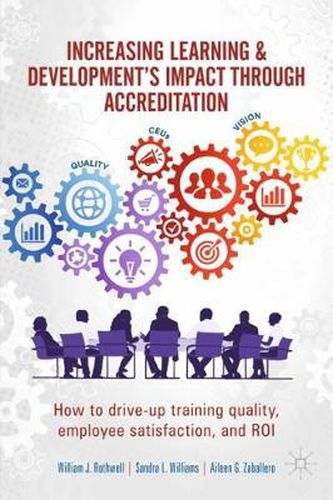Readings Newsletter
Become a Readings Member to make your shopping experience even easier.
Sign in or sign up for free!
You’re not far away from qualifying for FREE standard shipping within Australia
You’ve qualified for FREE standard shipping within Australia
The cart is loading…






This title is printed to order. This book may have been self-published. If so, we cannot guarantee the quality of the content. In the main most books will have gone through the editing process however some may not. We therefore suggest that you be aware of this before ordering this book. If in doubt check either the author or publisher’s details as we are unable to accept any returns unless they are faulty. Please contact us if you have any questions.
This book provides a guide to the process of accrediting training programs, sets out how to achieve consistent measurement of the results of training, and explains why accreditation is critical for capturing and developing today’s workers’ skills, aiding retention, and boosting strategic organizational credibility with millennials.
Workplace and executive training is a multi-billion dollar industry and yet an enormous percentage of that budget is spent on programs that have never been rigorously examined to ensure that they are fit for purpose and deliver value for the money.
If you’re signing off on that budget, or asking your people to spend time on training programs, shouldn’t that concern you?
Training accreditation offers vital quality assurance, ensures global consistency of results and delivers accountability for learning and performance outcomes.
Apart from delivering better results and greater ROI, organizations can differentiate themselves from their competitors in the employment marketplace by offering accredited proprietary training. After all, digital natives, and indeed all of today’s most talented potential employees, expect (and increasingly demand) the high quality, engaging and transferable employee development that only accredited programs can deliver.
Aligning with the standards set by the International Association of Continuing Education and Training (IACET) - today’s premier accreditation body for training programs - the authors offer principles for quality program structure, delivery, and improvement needed to achieve accreditation.
They share practices used by high quality training program managers today, covering business alignment and program administration along with the planning, design, delivery and evaluation of learning systems.
$9.00 standard shipping within Australia
FREE standard shipping within Australia for orders over $100.00
Express & International shipping calculated at checkout
This title is printed to order. This book may have been self-published. If so, we cannot guarantee the quality of the content. In the main most books will have gone through the editing process however some may not. We therefore suggest that you be aware of this before ordering this book. If in doubt check either the author or publisher’s details as we are unable to accept any returns unless they are faulty. Please contact us if you have any questions.
This book provides a guide to the process of accrediting training programs, sets out how to achieve consistent measurement of the results of training, and explains why accreditation is critical for capturing and developing today’s workers’ skills, aiding retention, and boosting strategic organizational credibility with millennials.
Workplace and executive training is a multi-billion dollar industry and yet an enormous percentage of that budget is spent on programs that have never been rigorously examined to ensure that they are fit for purpose and deliver value for the money.
If you’re signing off on that budget, or asking your people to spend time on training programs, shouldn’t that concern you?
Training accreditation offers vital quality assurance, ensures global consistency of results and delivers accountability for learning and performance outcomes.
Apart from delivering better results and greater ROI, organizations can differentiate themselves from their competitors in the employment marketplace by offering accredited proprietary training. After all, digital natives, and indeed all of today’s most talented potential employees, expect (and increasingly demand) the high quality, engaging and transferable employee development that only accredited programs can deliver.
Aligning with the standards set by the International Association of Continuing Education and Training (IACET) - today’s premier accreditation body for training programs - the authors offer principles for quality program structure, delivery, and improvement needed to achieve accreditation.
They share practices used by high quality training program managers today, covering business alignment and program administration along with the planning, design, delivery and evaluation of learning systems.